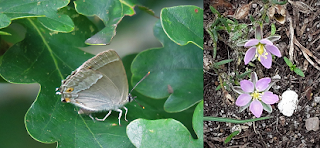July 22nd Norwich
I spent the afternoon plant hunting in parts of Norwich I didn't visit yet. First was Earlham Cemetery where I was told broad-leaved helleborines had been seen up until last year when they were apparently mowed down before they could flower. Did the cemetery owners learned a lesson and left these scarce city orchids to recover? Not that I could tell. I couldn't find them in the whereabouts that I was directed to. So I think these orchids are no more sadly.
After walking to the market for lunch, I made my way to a patch of unused grass along Queens Road where I was told that narrow-leaved ragwort grew. I found the plant surprisingly easily. It has ragwort like flowers, but were more loose than growing in a cluster like most ragworts I've seen and the leaves were noticeably thin as the name suggested. However, when it came to looking it up in my plant ID books when I got home, I couldn't find it in any of them. I had to look it up online to learn more about it. Apparently, this is an escapee originating from South Africa that has now colonised across Europe.
July 28th Norwich
A walk along the river Wensum. I didn't find too many new things for my plant list. However, I did discover new locations of plants that I found before such as fumitory, hare's-foot clover and flowering rush (that was growing much closer to my side of the river). New additions include upright hedge parsley, rose campion and teasel.
July 30th Strumpshaw Fen
It feels like forever since I was last here. The last time I was at Strumpshaw was in March on the day they made the decision to close up half way into my shift due to lockdown. At the start of July, the reserve finally reopened itself to the public albeit with restrictions as the staff had to come up ways to follow regulation rules to keep everyone safe yet allow everyone to enjoy nature. Yesterday, I finally had the opportunity to visit with Dad to see what changes were made.
First thing I noticed was the Reception Hide area. Picnic benches were placed near the fence of the courtyard, signs were placed everywhere including one telling you that only one family/person was allowed in the toilets at a time and, perhaps the most drastic change, the blind by the hide (currently locked) had the back panel opened up for easy access for one family at a time to view the broad.
A one-way system was put in place across the reserve with arrowed signs telling you where and where not to go. At the top of Sandy Wall, you then had the choice to go either towards the pumphouse and the woods or along the river and down the Lackford Run. Either direction led to a long walk to get back to the reserve's entrance without disobeying the arrow system. I encountered only 2 families going back the wrong direction along Sandy Wall, everyone else seemed fine with this system. Another thing I noticed was that as all the hides were closed, the path leading to Fen Hide was now overgrown completely.
It was a very hot day on my return to Strumpshaw, a complete contrast to when I was last here in March. I have missed this place. I have missed the wildlife, the familiar faces I see every week and even the hectic chaos of the swallowtail season. Though, I did see a swallowtail at Hickling last month, it didn't have the same fanfare of having hundreds of people from far and wide armed with cameras crowding around one fluttering over the flower bed. The swallowtail season is now over (at least for the first wave) and now the baton is handed over to the next impressive butterfly on the reserve, the silver-washed fritillary. Though my priority was to explore post-lockdown Strumpshaw, seeing one of these butterflies would make my day even better.
Exploring the reserve on such a hot day was energy sapping and the wildlife mirrored this feeling. It was very quiet and only insects seemed to be the most visible lifeforms around, everything else appeared to be hiding, sheltering from the heat. Dad and I sat down on the platformed bench at the top of Sandy Wall for a moment. Suddenly, we noticed something cat-sized stroll by like a cat with a crow or something in its mouth, wings being dragged along the ground before disappearing part way down Sandy Wall into a reed bed. What was it? I wasn't sure, but I think possibly a mink, though it could also had been a stoat. All I saw was something brown with slightly fluffy or waterlogged fur and was as big as a cat, perhaps an inch or two smaller. It went by so fast in its leisurely pace that I couldn't grab the camera quick enough.
 |
| Silver-washed Fritillary |







